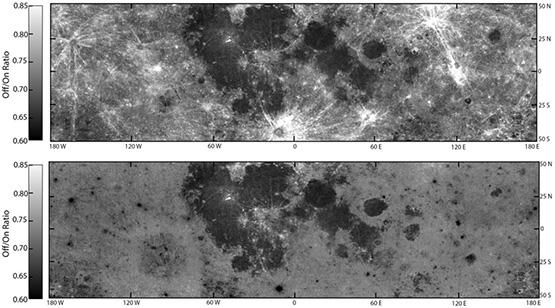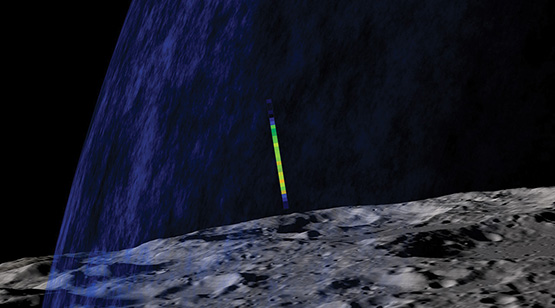Recent studies led by graduates of SwRI’s joint graduate program in physics and astronomy with The University of Texas at San Antonio demonstrate new techniques to understand the composition of lunar surfaces.
The studies used data from the SwRI-developed and -led Lyman Alpha Mapping Project (LAMP) instrument aboard NASA’s Lunar Reconnaissance Orbiter (LRO), a robotic mission launched in 2009 to study the surface of the Moon and investigate potential future landing sites.
LAMP’s primary purpose is to find water ice in deep polar craters using background ultraviolet light generated by stars. However, scientists are finding expanded uses for LAMP data.
Composition, Evolution of Lunar Surfaces
A study led by Dr. Benjamin Byron, a post-doctoral researcher at NASA’s Jet Propulsion Laboratory, focused on measuring reflections of far-ultraviolet (FUV) light to understand the composition of lunar surfaces. LAMP’s FUV observations indicate that the lunar surface reflectance in the ultraviolet wavelength is sensitive to changes in both composition and maturity. This can lead to uncertainties in the interpretation of the composition of features because space weathering over time dims older surfaces, while fresh impact craters are more reflective.
“We are using the optical maturity parameter to normalize these younger features in our maps of the lunar surface,” said Byron, who conducted the research during his SwRI-UTSA graduate program. “This method had previously been used for other regions of the spectrum, but we’ve shown for the first time that it can be used for the far UV as well.”
The team used existing observations that characterized the surface maturity at visible wavelengths to apply an index called the optical maturity parameter. Byron removed maturity-related features from far-UV maps of the lunar surface so that only data about the surface’s composition remained.
“What we see in our far-UV maps is a close correlation with composition maps from other regions of the electromagnetic spectrum,” Byron said. “We’re seeing these composition-related trends stand out in our maps more clearly than they had before, which allows us to have a global view of composition in the far-UV. It just goes to show that far-UV instruments such as LAMP are useful in performing compositional mapping for the Moon and for other bodies as well.”
While far-UV spectrographs have been used to study the atmosphere and exosphere of other planetary bodies before, LAMP is the first to measure the composition of the lunar surface using reflected light in these wavelengths.
“I think this work shows how important it is to include instruments like these on future missions to asteroids and other planetary bodies without atmospheres,” Byron said.

Courtesy of NASA.
A new study used LAMP data to determine the composition of areas on the lunar surface by measuring the reflectance of far-ultraviolet light. The top image shows younger, less mature features such as impact craters while the bottom image removed these features to isolate the composition of lunar surfaces.

Courtesy of ASA/GSFC Scientific Visualization Studio.
SwRI scientists joined a team that reanalyzed and modeled decade-old data about materials ejected by an impact, shown here passing through LAMP’s field of view. The new findings suggest that volatile materials in the permanently shaded region near the lunar south pole were likely delivered by a comet.
Comet Delivery to Moon
SwRI scientists joined a team that reanalyzed and modeled data from a planned lunar impact more than a decade ago. The findings suggest that volatiles present in a crater near the Moon’s south pole were likely delivered by a comet. Volatiles are chemical elements and compounds that can be readily vaporized and, in this case, were stabilized in ice lurking in this permanently shaded region (PSR).
LAMP had a bird’s eye view when its launch vehicle’s spent upper stage intentionally struck the Moon’s Cabeus crater in 2009. LRO and the Lunar CRater Observation and Sensing Satellite (LCROSS) launched together and monitored the plumes of materials ejected into the atmosphere in this planned experiment to excavate and understand the origin and evolution of volatiles in this inky crater.
“The new research indicates that the crater materials are not volcanic in origin and are best explained by cometary impact delivery,” said SwRI’s Dr. Kurt Retherford, LAMP principal investigator. “Ruling out volcanic sources could mean that the top three meters of regolith in the Cabeus crater are younger than previously thought, probably less than a billion years old.”
The most likely sources of the volatiles investigated were volcanic outgassing, comet or micrometeoroid impacts, and surface chemistry initiated by solar wind particles. For this research, the team looked at plumes of materials measured by LCROSS and LAMP and what they revealed about the composition of volatiles in the regolith. To simplify the analysis and eliminate as many influences as possible, the team compared the elemental composition of the volatiles to that of the potential sources, evaluating abundances of four elements — hydrogen, nitrogen, oxygen and sulfur — as they relate to carbon.
“Based on the ratios measured and the composition of comets, such as Rosetta spacecraft measurements of Comet 67P, comets are likely the primary source of these volatiles,” said Dr. Lizeth Magaña, a recent graduate of the SwRI-UTSA program who recently joined the Johns Hopkins University’s Applied Physics Laboratory.
“Studying these potential lunar resources not only supports expanded human exploration, but also helps us to understand the history of the Earth-Moon system,” said JHUAPL’s Dr. Kathleen Mandt, the lead author of a paper published in Nature Communications about this research. Mandt, a LAMP coinvestigator, was also a UTSA graduate and SwRI researcher prior to joining JHUAPL in 2017.
Present UTSA-SwRI graduate students continuing lunar studies with the LAMP team are Elizabeth Czajka, Caleb Gimar, Joanna Wedemeyer, Bereket Mamo, Mikhail Sharov and Patrice Smith.
Questions about this story or Planetary Science? Contact Kurt Retherford at +1 210 522 3809

